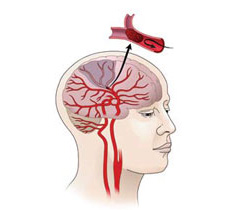IRP Scientists Curb Inflammation to Protect Brain Cells From Stroke

New research by IRP scientists suggests that blocking the action of an enzyme called MAGL could help brain cells survive an ischemic stroke.
Every forty seconds, someone in the United States suffers a stroke, and researchers across the country are hunting for a way to help brain cells survive these traumatic events. A group of IRP researchers recently discovered a promising new tool to aid in this effort. By blocking the action of a brain chemical called monoacylglycerol lipase (MAGL), the scientists markedly reduced stroke-related brain damage and disability in rats.1
Nearly nine in ten strokes are classified as ‘ischemic,’ meaning they occur when blood flow is cut off to part of the brain. Deprived of oxygen and nutrients, the brain cells in the affected area quickly die off, and soon afterwards inflammation destroys additional cells nearby. Previous research has shown that stroke-induced oxygen deprivation activates MAGL in order to kick off the chain of events that triggers inflammation.
“Inflammation exacerbates the way that the tissue reacts to the lack of blood flow, so if you contain it then you can salvage a significant portion of the affected area,” says IRP Senior Investigator Afonso C. Silva, Ph.D., the new study’s senior author.
Dr. Silva and his colleagues tested an MAGL inhibitor, called JZL184, in three different rat models of stroke. Half of the animals were from a strain of ‘spontaneously hypertensive’ rats bred to have high blood pressure — a significant risk factor for stroke — while the other half had normal blood pressure. The rats received the MAGL inhibitor an hour after the initiation of their strokes.
In the first stroke model the researchers tested, they used a chemical naturally produced in the brain that constricts blood vessels to cause a temporary, localized disruption in blood flow to a specific part of the brain called the somatosensory cortex. In both strains of rats, the MAGL inhibitor dramatically reduced the number of brain cells affected by the stroke. The treatment also curbed brain swelling, particularly in the hypertensive rats, whose strokes affected much large portions of the brain than those in the rats with normal blood pressure. Subsequent tests of motor function in the hypertensive animals showed that the rats given the MAGL inhibitor had less severe movement and coordination problems than those given a placebo. Hypertensive rats treated with a second compound that inhibits MAGL even more specifically, called MJN110, also showed less stroke-related brain damage and better motor function than untreated rats, confirming that the improvements stemmed from blocking MAGL rather than some other process.
In the other two stroke models, which were intended to mimic strokes affecting larger portions of the brain, the researchers either temporarily or permanently blocked a major blood vessel called the middle cerebral artery (MCA). In the hypertensive rats, inhibiting MAGL significantly reduced the extent of the brain damaged by the stroke in animals whose MCAs were permanently blocked, but not in those whose MCAs were blocked only temporarily. Dr. Silva theorizes that this difference occurred because the rats’ nearly life-long hypertension had reduced the ability of their blood vessels to carry the MAGL inhibitor to the affected part of the brain.
Further experiments revealed that the MAGL inhibitor reduced the levels of several chemicals associated with inflammation in the brain, lending credibility to Silva’s prediction that blocking MAGL could benefit stroke patients by reducing inflammation.
“At the time point we looked at immediately after stroke, inflammation is the main determinant of the fate of the tissue,” Dr. Silva says, so stopping it early on would likely yield substantial benefits for patients.
Dr. Silva now plans to examine the effects of inhibiting MAGL days or weeks after stroke and to expand his studies into other animal models.
“Our study really makes the case for the importance of curbing inflammation early after an ischemic stroke,” Dr. Silva says. “We hope this study will lead to the development of a pharmaceutical-grade compound that can be used in clinical trials with human patients.”
Subscribe to our weekly newsletter to stay up-to-date on the latest developments in the NIH Intramural Research Program.
References:
[1] Neuroprotective Effects of MAGL (Monoacylglycerol Lipase) Inhibitors in Experimental Ischemic Stroke. Choi SH, Arai AL, Mou Y, Kang B, Yen CC, Hallenbeck J, Silva AC. Stroke. 2018 Mar;49(3):718-726. doi: 10.1161/STROKEAHA.117.019664. Epub 2018 Feb 13.
Related Blog Posts
This page was last updated on Tuesday, January 30, 2024
